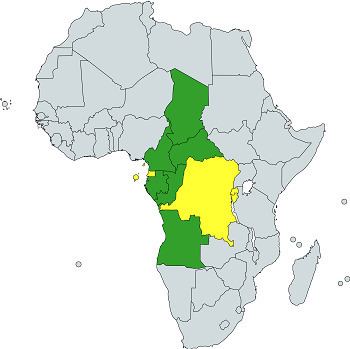Signed and ratified Only signed Parties 6 | Signatories 11Complete List | |
 | ||
Signed 19 November 2010 (2010-11-19) Condition Ratification by 6 states | ||
The Central African Convention for the Control of Small Arms and Light Weapons, their Ammunition, Parts and Components that can be used for their Manufacture, Repair or Assembly, also known as the Kinshasa Convention, aims at regulating small arms and light weapons (SALW) and combating their illicit trade and trafficking in Central Africa.
Contents
The convention was negotiated within the framework of the UN Standing Advisory Committee on Security Questions in Central Africa (UNSAC), and unanimously adopted on 30 April 2010 in Kinshasa, Democratic Republic of the Congo, at the 30th ministerial meeting of the Committee. As of 22 September 2011, it had been signed by the eleven member states of the Committee: Angola, Burundi, Cameroon, Chad, Democratic Republic of Congo, Equatorial Guinea, Gabon, the Central African Republic, Rwanda, the Republic of the Congo and São Tomé and Príncipe. As of February 2017, Angola, Cameroon, the Central African Republic, Chad, Gabon and the Republic of the Congo have ratified the Convention. The convention will enter into force on 8 March 2017, following the deposit of the sixth instrument of ratification by Angola.
Purpose of the Convention
The purpose of the Kinshasa Convention, as stated in Chapter I, Article 1, is to:
Area of application
"Central Africa" refers to the geographical area covering the 11 States that are members of the United Nations Standing Advisory Committee on Security Questions in Central Africa, namely, the Republic of Angola, the Republic of Burundi, the Republic of Cameroon, the Central African Republic, the Republic of Chad, the Republic of the Congo, the Democratic Republic of the Congo, the Republic of Equatorial Guinea, the Gabonese Republic, the Republic of Rwanda and the Democratic Republic of Sao Tomé and Principe.
History
The United Nations Standing Advisory Committee on Security Questions in Central Africa (UNSAC) was established by the Secretary-General of the United Nations on 28 May 1992, pursuant to General Assembly resolution 46/37 B of 6 December 1991. Its primary objective is to promote peace and security in Central Africa through confidence-building measures, notably in the fields of disarmament and arms limitation. UNSAC comprises the ten member States of the Economic Community of Central African States (ECCAS) and the Republic of Rwanda.
In his statement opening the 25th ministerial meeting of UNSAC, in May 2007, the President of São Tomé and Príncipe invited the Committee to support the elaboration of a subregional legally binding instrument on illicit SALW and its accompanying implementation plan, in order to strengthen the capacity of Central African States to combat illicit small arms and light weapons and their governance of the security sector, as well as a Code of Conduct for the Defense and Security Forces in Central Africa. This proposal became known as the São Tomé Initiative.
The Central African Convention for the Control of Small Arms and Light Weapons, their Ammunition, Parts and Components that can be used for their Manufacture, Repair or Assembly, dubbed Kinshasa Convention, was unanimously adopted on 30 April 2010 by all eleven member States of UNSAC at its 30th ministerial meeting held in Kinshasa, Democratic Republic of the Congo.
The Convention was opened for signature on 19 November 2010 in the context of UNSAC's 31st ministerial meeting held in Brazzaville, Republic of the Congo. Eight of the eleven UNSAC members States signed the Convention on this occasion; Burundi, Equatorial Guinea and Rwanda signed it shortly thereafter. The Convention Implementation Plan, which was developed alongside the Convention to ensure the feasibility of the implementation process, was adopted at this occasion.
Following the ratification of the Convention by Angola on 6 February 2017, the sixth such instrument of ratification, the Kinshasa Convention will enter into force on 8 March 2017.
Analysis
The Kinshasa Convention is the most recent small arms control and disarmament legal instrument elaborated within the United Nations framework.
This Convention, which addresses the security, legal, institutional and cultural specificities of the Central African subregion, demonstrates the eleven UNSAC countries' willingness to establish a coherent subregional strategy to act collectively against illicit arms and ammunition. The mobilization of the eleven Central African countries to negotiate this arms control and disarmament instrument contributes also to a significant confidence-building measure amongst countries, the majority of which had been at war with each other.
The Convention's scope is broad and takes into account the most recent developments in global and regional initiatives aimed at combating illicit small arms and light weapons. The Convention also draws upon the best practices and experience of the African and other regions. Its elaboration process was also unique to the extent that both the Convention and its implementation plan were carried out in parallel, with a view to ensuring a "reality check" at the conclusion of various legal provisions implying obligations for States to carry out specific measures.
The Ministers' direct involvement in the elaboration of the Kinshasa Convention and its adoption strengthens the importance of the Convention and constitutes a significant step towards a subregional coherent strategy to act against illicit arms and ammunition. The conclusion of such a significant and complex legal instrument in such a short period of time is a significant demonstration of the subregion's determination to tackle one of its biggest challenges.
This Convention fills a void as Central Africa was one of the African subregions not to have its own legal instrument for the control of small arms and light weapons.
Signature and Ratification
As of 22 September 2011, all eleven Central African States have signed the Kinshasa Convention. As of February 2017, Angola, Cameroon, the Central African Republic, Chad, the Republic of the Congo and Gabon have ratified it. The Kinshasa Convention will enter into force on 8 March 2017
